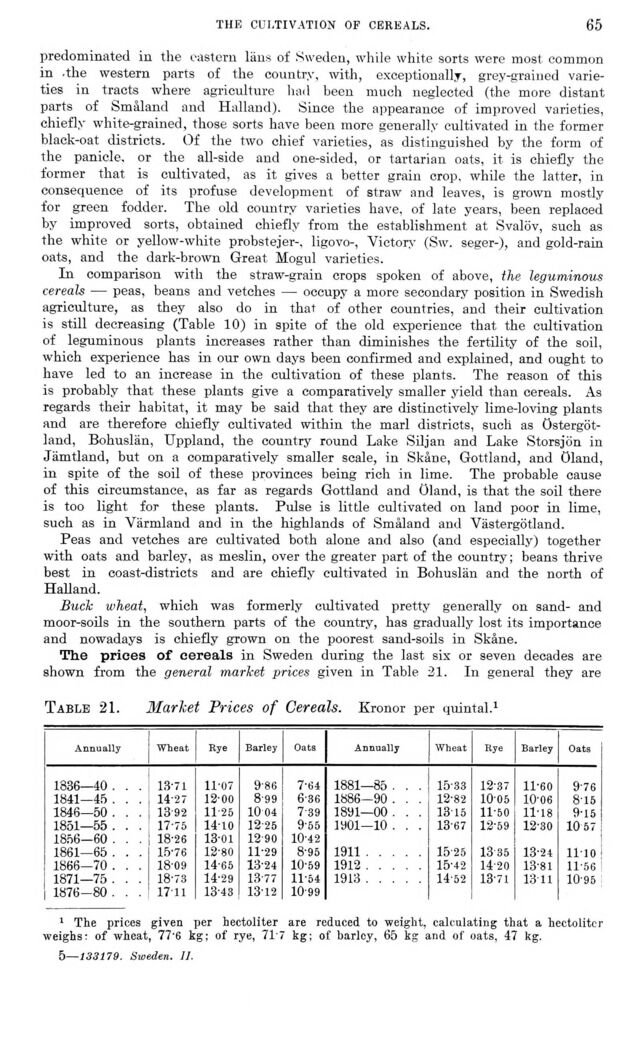
Full resolution (JPEG) - On this page / på denna sida - III. Rural Husbandry. Introd. by H. Juhlin Dannfelt - 1. Agriculture. By H. Juhlin Dannfelt

<< prev. page << föreg. sida << >> nästa sida >> next page >>
Below is the raw OCR text
from the above scanned image.
Do you see an error? Proofread the page now!
Här nedan syns maskintolkade texten från faksimilbilden ovan.
Ser du något fel? Korrekturläs sidan nu!
This page has never been proofread. / Denna sida har aldrig korrekturlästs.
the cultivation of cereals.
65
predominated in the eastern läns of Sweden, while white sorts were most common
in -the western parts of the country, with, exceptionally, grey-grained
varieties in tracts where agriculture had been much neglected (the more distant
parts of Småland and Halland). Since the appearance of improved varieties,
chiefly white-grained, those sorts have been more generally cultivated in the former
black-oat districts. Of the two chief varieties, as distinguished by the form of
the panicle, or the all-side and one-sided, or tartarian oats, it is chiefly the
former that is cultivated, as it gives a better grain crop, while the latter, in
consequence of its profuse development of straw and leaves, is grown mostly
for green fodder. The old country varieties have, of låte years, been replaced
by improved sorts, obtained chiefly from the establishment at Svalöv, such as
the white or yellow-white probstejer-, ligovo-, Victory (Sw. seger-), and gold-rain
oats, and the dark-brown Great Mogul varieties.
In comparison with the straw-grain crops spoken of above, the leguminous
cereals — peas, beans and vetches — occupy a more secondary position in Swedish
agriculture, as they also do in that of other countries, and their cultivation
is still decreasing (Table 10) in spite of the old experience that the cultivation
of leguminous plants increases rather than diminishes the fertility of the soil,
which experience has in our own days been confirmed and explained, and ought to
have led to an increase in the cultivation of these plants. The reason of this
is probably that these plants give a comparatively smaller yield than cereals. As
regards their habitat, it may be said that they are distinctively lime-loving plants
and are therefore chiefly cultivated within the marl districts, such as
Östergötland, Bohuslän, Uppland, the country round Lake Siljan and Lake Storsjön in
Jämtland, but on a comparatively smaller scale, in Skåne, Gottland, and Öland,
in spite of the soil of these provinces being rich in lime. The probable cause
of this circumstance, as far as regards Gottland and Öland, is that the soil there
is too light for these plants. Pulse is little cultivated on land poor in lime,
such as in Värmland and in the highlands of Småland and Västergötland.
Peas and vetches are cultivated both alone and also (and especially) together
with oats and barley, as meslin, over the greater part of the country; beans thrive
best in coast-districts and are chiefly cultivated in Bohuslän and the north of
Halland.
Buck wheat, which was formerly cultivated pretty generally on sand- and
moor-soils in the southern parts of the country, has gradually lost its importance
and nowadays is chiefly grown on the poorest sand-soils in Skåne.
The prices of cereals in Sweden during the last six or seven decades are
shown from the general market prices given in Table 21. In general they are
Table 21. Market Prices of Cereals. Kronor per quintal.1
Annually Wheat Rye Barley Oats
1836—40 . . . 13-71 11-07 9-86 7-64
1841—45 . . . 14-27 12-00 8 99 636
1846—50. . . 13-92 11 25 10 04 739
1851—55 . . . 17-75 1410 12-25 9-55
1856—60 . . . 18-26 13-01 12-90 10-42
1861—65 . . . 15-76 12-80 11-29 8-95
1866-70 . . . 1809 14-65 13-24 10-59
1871-75. . . 18-73 14-29 1377 11-54
1876-80 . . . 1711 13-43 13-12 10-99
1881—85 . . . 15-33 12-37 11-60 9-76
1886—90 . . . 12-82 10 05 10-06 8 15
1891—00 . . . 13-15 11-50 11-18 9-15
1901—10 . . . 13-67 12-59 12-30 10 57
1911 ..... 15-25 13-35 13-24 ll-io <
1912 ..... 15-42 14-20 13-81 11-56
191 3.....14-52 13-71 13-11 10-95
1 The prices given per hectoliter are reduced to weight, calculating that a hectoliter
weighs: of wheat, 77’6 kg; of rye, 717 kg; of barley, 65 kg and of oats, 47 kg.
5—133179. Sweden. II.
<< prev. page << föreg. sida << >> nästa sida >> next page >>